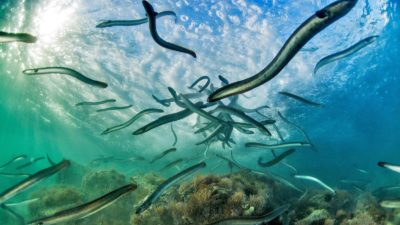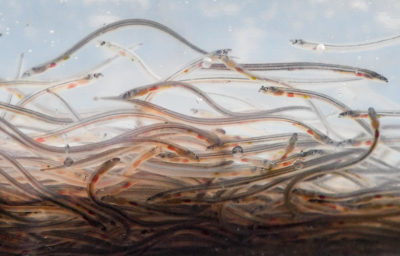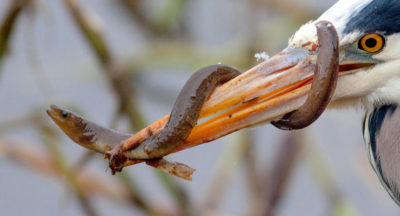Long, V-shaped eel traps cross from shore to shore on Italy’s Comacchio Lagoons, pointing like arrowheads out to the Adriatic Sea. When eels headed to their ocean breeding grounds arrive at the tip of the V, aluminum panels allow them into the trap, but not out. Metal replaced wood and reeds in the 1980s, but otherwise the design of the trap is the same as it has been since ancient times.
On a recent foggy morning at Comacchio, I met up with Stefano Gelli, who was clearing a trap in one of the lagoons’ northern basins. When Gelli was growing up, 40 years ago, a single night’s catch could total 10 tons.
“…Sixteen, seventeen…” Gelli grabbed tight onto the slimy fish and tossed them into a plastic tub, where they slithered over each other in slimy circles. “…eighteen, nineteen.” He threw in the last one. Comacchio’s eels once filled the lagoons; now they fit inside a bucket.
For thousands of years, the ubiquity of this fatty fish made eels the backbone of poor men’s diets across the continent. They were served in soups and risottos in Italy, fried to a crisp and stacked on crackers in Spain, boiled to a soft texture in Scandinavia, set floating in a gelatinous goop in England, smoked in their skin in Germany and Holland, and enjoyed as a Christmastime staple everywhere.
For many biologists, closing down the European eel fishery seems like the last option left after many years of neglect.
Yet so calamitous has the collapse of the European eel population been over the last half-century, the species now risks going the way of the passenger pigeon. In 2008, the International Union for Conservation of Nature took the step of classing the European eel (Anguilla anguilla) as critically endangered. Around the same time, the European Union adopted a comprehensive eel regulation establishing measures to support the recovery of the stock, including through seasonal fishing closures and limits.
But a recovery has failed to materialize, and scientists now say that only urgent and extreme action can save this iconic fish. In its annual report for 2024, the International Council for the Exploration of the Sea (ICES) — the regional fishery advisory body whose findings provided the basis for the EU’s Eel Regulation — is now urging that “there should be zero catches in all habitats.” For many biologists, closing down the eel fishery, at least temporarily, seems like the last option left after many years of neglect. “It’s been a century of ‘we knew the problem and we didn’t face it,’” Willem Dekker, a Dutch biologist known as the architect of the EU Eel Regulation, told me.
Eels are at once a familiar component of European culture and a mystery to everyone who has ever studied them. Aristotle tried to crack the question of eel reproduction as early as the 300s B.C., eventually concluding that the fish must miraculously generate out of muddy riverbeds. At the time, no one had found the eels’ sex organs. Nor had they witnessed eels reproducing in the wild, a page in the scientific record that remains blank to this day: no pair of European eels has ever been caught in the act.
European eels are born in the Sargasso Sea, an amorphous body of water in the Western Atlantic bordered not by land but by shifting ocean currents. The tiny, transparent, larvae are then carried on the current to Europe’s Atlantic and Mediterranean shores. Here, they complete their first metamorphosis into longer but still transparent “glass eels.” Glass eels travel up freshwater streams and rivers, where they settle on a long-term home, living for years or decades as longer and darker “yellow eels” before finally transitioning to shiny and reproductively mature “silver eels.” At that point, some unknown force calls them to swim down to unfathomable depths on a migration of nearly a thousand miles back to the Sargasso Sea, where they spawn, and then die.
Both the European eel’s ovaries and testes develop in earnest only en route to the Sargasso Sea, and it wasn’t until the late 1700s that the ovaries of a female eel (hailing from the Comacchio Lagoon) were first identified through meticulous anatomical dissection. The testes took even longer to find. A young Sigmund Freud — then a medical student on his way to becoming the philosopher supreme of sexual repression –—was one of many men who toiled above the scalpel to find the male eel’s reproductive organs. (Freud spent the spring of 1876 in Trieste, about a hundred miles northeast of Comacchio, fruitlessly picking apart healthy eels from the Adriatic for his advisor in Vienna.)
The market for young European eels is strongest in Asia, where traffickers are shipping staggering quantities of glass eels.
The eel’s mysterious life cycle resists standard fisheries science. To create management plans, biologists often rely on a figure called the spawning stock biomass, or SSB, which is calculated as the total biomass of reproductively mature fish. Since reproductively mature European eels hide far out of sight in the dark depths of the Atlantic, there is no way to accurately estimate the species’ SSB. “Fish stock assessment is a routine business and involves a lot of mathematics,” said Willem Dekker. “There are protocols for how to do it.” In the case of European eel, “doing those things without knowledge, without data, without the hard models that make life so easy, makes it much more challenging.”
No one has figured out how to breed and raise eels artificially, either. Scientists have managed to induce European eel reproduction in labs through hormone treatments, but the difficulty of determining the environmental conditions and diet that eel larvae need to survive has meant that few lab-raised eels live for more than three months. Therefore, eel farms must rely on a supply of wild-captured glass eels that they can then raise to commercial size. The market for young European eels is strongest in Asia, where traffickers are shipping staggering quantities of glass eels to satisfy the Japanese appetite for the fish, in direct violation of a 2010 EU law prohibiting the export of eels beyond EU borders.
Young glass eels at a fishery in Storkow, Germany. Patrick Pleul / dpa Picture-Alliance / Alamy Stock Photo
Since management authorities cannot rely on aquaculture to meet market demand and relieve pressure on wild eel stocks, they have had to focus on more direct conservation strategies. But they are struggling to come up with solutions, since the reasons for the European eel’s collapse are not straightforward. Data collection has revealed a 15 percent annual drop in the levels of glass eels arriving at European coasts beginning in 1980. There are clearly a number of factors at play in this long decline, but the extent of each is uncertain.
Overfishing, it seems, is only one piece of the puzzle, as shown by the failure of the EU’s fishing regulations to produce a recovery. Another is habitat destruction, as dams, hydropower plants, and land reclamation cut off important migration routes. Diseases, such as Anguillid herpesvirus, as well as heavy metals and pollutants, are also known to lower eels’ reproductive chances, and a warming Atlantic may be shifting the currents eels rely on to complete their life cycle. The recent surge of illegal trafficking of juveniles to Asia has surely put another dent in the population.
“People want to have a clear answer, but we’re not able to provide it,” admitted Caroline Durif, one of the current chairs of the ICES Working Group on Eels. When asked the reason for the eels’ sharp decline, Willem Dekker said, “I don’t know. Full stop. Fishing, habitat loss, pollution, all those things, nobody knows.”
The mysteries surrounding the eel allow different groups with their own priorities to shift the blame for the collapse.
In order to ban the capture of European eels, as proposed by ICES, the European Parliament would need to repeal and amend the current EU directive requiring countries to adopt measures to support the stock’s recovery. This seems unlikely given that a 2023 committee vote on a resolution calling for renewed commitment to the regulation won the support of 80 percent of delegates present. “There’s no will to do a ban, and also it wouldn’t help,” Andrew Kerr, the chair of a nonprofit coalition of conservationists, scientists, and commercial fishermen called the Sustainable Eel Group (SEG), told me over video call from his home in England. “The eel is much more complex than that, and if you stop fishing, you’re not going to save the eel. What you need is a very controlled level of fishing, but we have to work on all the environmental factors.”
Durif acknowledges that the EU still needs some convincing from the scientific community before it will accept a zero-catch limit. “The EU is working on making a special request to ICES to see if we can measure the efficiency of the regulation, which we keep on saying we can’t,” she said. She noted that the advice for a ban follows the precautionary approach, a commonly agreed principle in fisheries to implement management measures, however drastic, aimed at reaching specific population points. “Since we don’t have the data to say whether this or that, hydropower or fisheries, is causing more mortality, we can’t give advice for less [than a ban], or more precise advice.”
The mysteries surrounding the eel allow different groups with their own priorities to shift the blame for the collapse. The SEG argues that the management focus should be on ensuring that glass eel fisheries, distributors, farms, smokehouses and retailers, which account for about 90 percent of the legal European market, operate within the bounds of existing EU regulations. The group has developed a standard for all commercial operators to follow for SEG certification and is also pushing to combat trafficking to Asia.
Kerr has been writing to the EU for over a decade and has spoken to gathered authorities at the Hague on the problem of illegal glass eel shipments. “It’s taken a long time to make eel become an EU priority in countertrafficking,” he said. In the late 2010s, police crackdowns gained speed. The 2017 discovery of $547,000 worth of glass eels hidden under crates of other legal fish in Heathrow Airport produced the headline “Trafficking makes eels ‘as valuable as cocaine’.” Operation LAKE, coordinated by Interpol between 2022 and 2023, led to the arrest of 256 people suspected of illegal eel trafficking.
In Sweden, the threat of hydropower plants to migrating eels is estimated to be equal to or greater than that posed by fishing.
Eel fishermen around Europe fear their livelihoods being put on hold by a fishing ban, and they argue that the authorities should be addressing other known mortality factors. In Sweden, the threat of the country’s 2,300 hydropower plants, whose turbines routinely tear migrating eels to shreds, is estimated to be equal to or greater than that posed by fishing. On the shores of Häno Bay in southeastern Sweden, also known as the Eel Coast, a group of fishermen and activists is campaigning to preserve the eel fishing traditions of the area, which date back to medieval times, when eel was a currency used to pay taxes, rent, and debts, and which survive in the form of traditional eel dinners inside the fishermen’s cottages. Dafvid Hermansson, a local historian and board member of Eel Coast Cultural Heritage, criticizes policymakers for evading the questions of hydropower turbines and habitat degradation, and opting to pick the “low-hanging fruit” of fishing restrictions. “Less than 1 percent of the fully grown, mature eels leaving the Swedish coastline are being fished,” he claimed.
Scientists, however, almost unanimously maintain that imposing a fishing ban is necessary, if not necessarily sufficient. Giuseppe Castaldelli, a biologist consultant for the Po Delta Park, which administers the Commachio Lagoons, insists: “We don’t want to extinguish the fishery. The tradition should stay. It’s only right. It’s the history of these places. But if we need to stop fishing for five years, let’s stop fishing for five years. The population numbers continue to go down; soon we risk going underneath the survival threshold of the species.”





